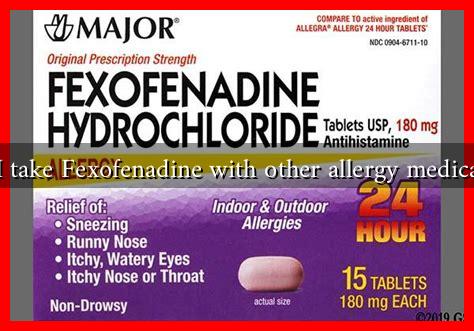-
Table of Contents
- Can I Take Fexofenadine with Other Allergy Medications?
- Understanding Fexofenadine
- Common Allergy Medications
- Combining Fexofenadine with Other Allergy Medications
- 1. Safety of Combining Antihistamines
- 2. Fexofenadine and Decongestants
- 3. Fexofenadine and Corticosteroids
- Consulting Healthcare Professionals
- Case Studies and Statistics
- Conclusion
Can I Take Fexofenadine with Other Allergy Medications?
Allergies can be a significant source of discomfort for many individuals, leading to symptoms such as sneezing, itching, and nasal congestion. Fexofenadine, a popular antihistamine, is often used to alleviate these symptoms. However, many people wonder whether it is safe to combine Fexofenadine with other allergy medications. This article explores the safety, efficacy, and considerations of taking Fexofenadine alongside other allergy treatments.
Understanding Fexofenadine
Fexofenadine is a second-generation antihistamine that is primarily used to treat allergic rhinitis and chronic urticaria (hives). Unlike first-generation antihistamines, Fexofenadine is less likely to cause drowsiness, making it a preferred choice for many individuals. It works by blocking the action of histamine, a substance in the body that causes allergic symptoms.
Common Allergy Medications
Before discussing the combination of Fexofenadine with other medications, it is essential to understand the types of allergy medications available:
- First-Generation Antihistamines: Examples include diphenhydramine (Benadryl) and chlorpheniramine. These can cause sedation and are often used for short-term relief.
- Second-Generation Antihistamines: Besides Fexofenadine, this category includes cetirizine (Zyrtec) and loratadine (Claritin). They are less sedating and have a longer duration of action.
- Decongestants: Medications like pseudoephedrine (Sudafed) can relieve nasal congestion but may cause increased heart rate and blood pressure.
- Corticosteroids: Nasal sprays like fluticasone (Flonase) help reduce inflammation in the nasal passages.
Combining Fexofenadine with Other Allergy Medications
When considering the combination of Fexofenadine with other allergy medications, it is crucial to evaluate potential interactions and the overall effectiveness of the treatment plan. Here are some key points to consider:
1. Safety of Combining Antihistamines
Combining Fexofenadine with other second-generation antihistamines, such as cetirizine or loratadine, is generally not recommended. While these medications have similar mechanisms of action, taking them together does not significantly enhance their effectiveness and may increase the risk of side effects.
2. Fexofenadine and Decongestants
Fexofenadine can be safely combined with decongestants like pseudoephedrine. This combination is often found in over-the-counter products designed for allergy relief, such as Allegra-D. The antihistamine component alleviates symptoms like sneezing and itching, while the decongestant helps relieve nasal congestion.
3. Fexofenadine and Corticosteroids
Using Fexofenadine alongside corticosteroid nasal sprays is also considered safe. This combination can provide comprehensive relief from allergy symptoms, as the antihistamine addresses immediate symptoms while the corticosteroid reduces inflammation over time.
Consulting Healthcare Professionals
Before combining Fexofenadine with any other allergy medications, it is essential to consult a healthcare professional. They can provide personalized advice based on your medical history, current medications, and specific allergy symptoms. This is particularly important for individuals with pre-existing health conditions or those taking multiple medications.
Case Studies and Statistics
Research indicates that many individuals benefit from combination therapy for allergies. A study published in the Journal of Allergy and Clinical Immunology found that patients using a combination of antihistamines and nasal corticosteroids reported a significant reduction in allergy symptoms compared to those using antihistamines alone.
Furthermore, a survey conducted by the American College of Allergy, Asthma, and Immunology revealed that nearly 60% of allergy sufferers use multiple medications to manage their symptoms effectively.
Conclusion
In summary, Fexofenadine can be safely combined with certain allergy medications, particularly decongestants and corticosteroids, to enhance relief from allergy symptoms. However, combining it with other antihistamines is generally not advisable. Always consult a healthcare professional before starting any new medication regimen to ensure safety and efficacy. By understanding the interactions and benefits of various allergy treatments, individuals can make informed decisions to manage their symptoms effectively.

